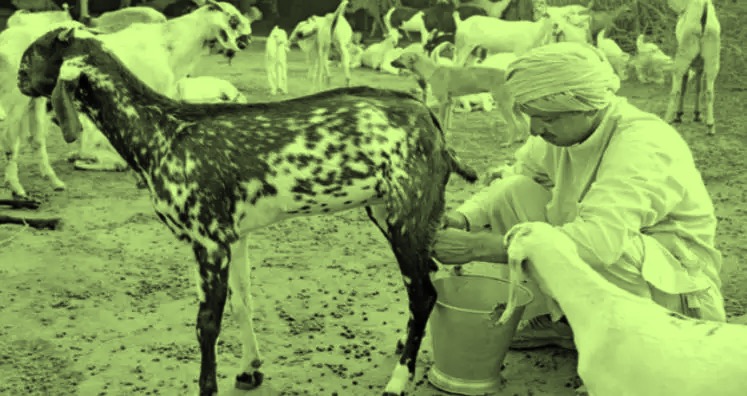A maldhari union wants Amul to sell the milk of goats separately, and the Gujarat govt has asked for details. It is true that Gandhiji preferred goat milk, and it has its advantages — but is a commercial operation viable?
Mahatma Gandhi preferred goat milk, and claimed that since goats eat plants, herbs, shrubs, and grass, their milk has health benefits. (Representational image/Express Photo By Pavan Khengre)
The Agriculture Minister of Gujarat, Raghavji Patel, has asked for a proposal on the possibility of branding and marketing the milk of goats, which is currently sold only informally.
The Minister met with representatives of a union of sheep and goat rearers from Surendranagar district in Saurashtra; the Gujarat State Co-operative Milk Marketing Federation (GCMMF), which owns Amul; the Surendranagar District Co-operative Milk Producers’ Union; and the director of the Gujarat Animal Husbandry Department on October 26.
What is the potential for goat milk in the state?
A survey by the Gujarat animal husbandry directorate estimated the state’s goat population at 50.55 lakh in 2021-22, and the goat milk production at 3.39 lakh tonnes (329 lakh litres; 1 litre is equal to 1.03 kg of milk). This was around 2% of the state’s total milk production.
A lactating doe produces 1.5-2 litres of milk every day on average. With a gestation period of around 150 days, a doe can have two litters of up to four kids each every year. Each lactation typically lasts for four months. Kids attain reproductive maturity within two years.
Gujarat has far fewer goats (48.67 lakh as per the 2019 Livestock Census) than states like Rajasthan (2.08 crore) and West Bengal, Uttar Pradesh, Bihar, Madhya Pradesh, and Maharashtra (all more than 1 crore each).
How has Amul reacted to the proposal?
GCMMF has 18 district cooperative milk producer unions, including Sursagar Dairy of the Surendranagar District Co-operative Milk Producers’ Union, procures around 259 lakh litres or around 2,667 tonnes of milk per day. About 51,000 litres — 5% — is camel milk that it started procuring from camel breeders in Kutch district five years ago. The rest is cow and buffalo milk.
Valamji Humbal, vice-chairman of GCMMF, said nowhere in India are organised dairy firms known to brand and market goat milk. “There is no doubt that goat milk is very good for health,” Humbal said, “but much depends on how a product is branded and marketed, and milk producers play a big role in this”. Launching any new product has its challenges, and a dairy will have to make capital investments in procurement, processing, and distribution channels, Humbal said.
“Informal discussions are on, but the low quantity of goat milk can be an issue. Nonetheless, if Sursagar Dairy agrees to take up the job of collection, Amul will accept goat milk and will help in its processing and marketing,” he said.
How can procurement by Amul help goat and sheep herders?
With no formal mechanism to sell their produce, pastoralists often prepare mava, an ingredient for many sweets, from goat milk, or sell the milk to tea stalls and hotels for around Rs 21 per litre. In some cases, goat milk is mixed with other milk and sold.
Naran Rabari, president of the Surendranagar Jilla Gheta-Bakra Uchherak Maldhari Sangathan (Surendranagar District Sheep-Goat Rearers’ Maldhari Union), the pastoralists’ organisation that is pushing for the separate collection and marketing of goat milk, said camel breeders were in a similar situation until Amul started procuring the milk through Sarhad Dairy of Kutch in 2018. Now, Rabari said, camel breeders get Rs 51 per litre of milk.
Baba Bharvad, chairman of Sursagar Dairy, said premium cheese can be made from goat milk.
Does this mean it is possible to turn the goat into a primarily milch animal?
Not really. Chaudhary said: “Given the quantity of milk that a goat produces daily, they may not be viable as milch-only animals. Goats have always been reared for both milk and meat — goat wool is coarse, and has no takers. Separate branding and marketing of goat milk can increase the earnings of pastoralists, but even then some goats will end up in slaughterhouses to keep the herd viable.”
Also, pastoralists don’t need male goats — just one good male is sufficient for a herd of 40 females,” he said. Billies make sense only for slaughter.
Adil Noor, secretary of the Livestock Exporters’ Association, a forum of livestock exporters of Gujarat, said 10,000 goats are traded in Ahmedabad’s goat market every week. “Goat meat costs around Rs 650-700 per kg, and a goat with an estimated 10 kg of meat could be sold for Rs 5,500-6,000 in the Indian market and for Rs 7,500 overseas,” Noor said.
Unlike camels, whose population fell from 40 lakh in 2012 to just 2.5 lakh in 2019, the goat population rose from 13.51 crore to 14.88 crore during this period.
What benefits does goat milk have?
Rabari recalled that Mahatma Gandhi preferred goat milk, and claimed that since goats eat plants, herbs, shrubs, and grass, their milk has health benefits.
Chaudhary, whose institute is carrying out research on the Surati breed of goats, said the fat content of goat milk is around 3%, which is similar to breast milk, and it has comparatively low solids-not-fat (SNF) content, and is hence easy for humans to digest.
“Doctors prescribe goat milk for neonates if the mother is not able to breastfeed. This is also the reason that lactose intolerant persons can consume goat milk without much difficulty,” he said.
Source : The Indian Express Nov 7th 2023 by Gopal B Kateshiya

